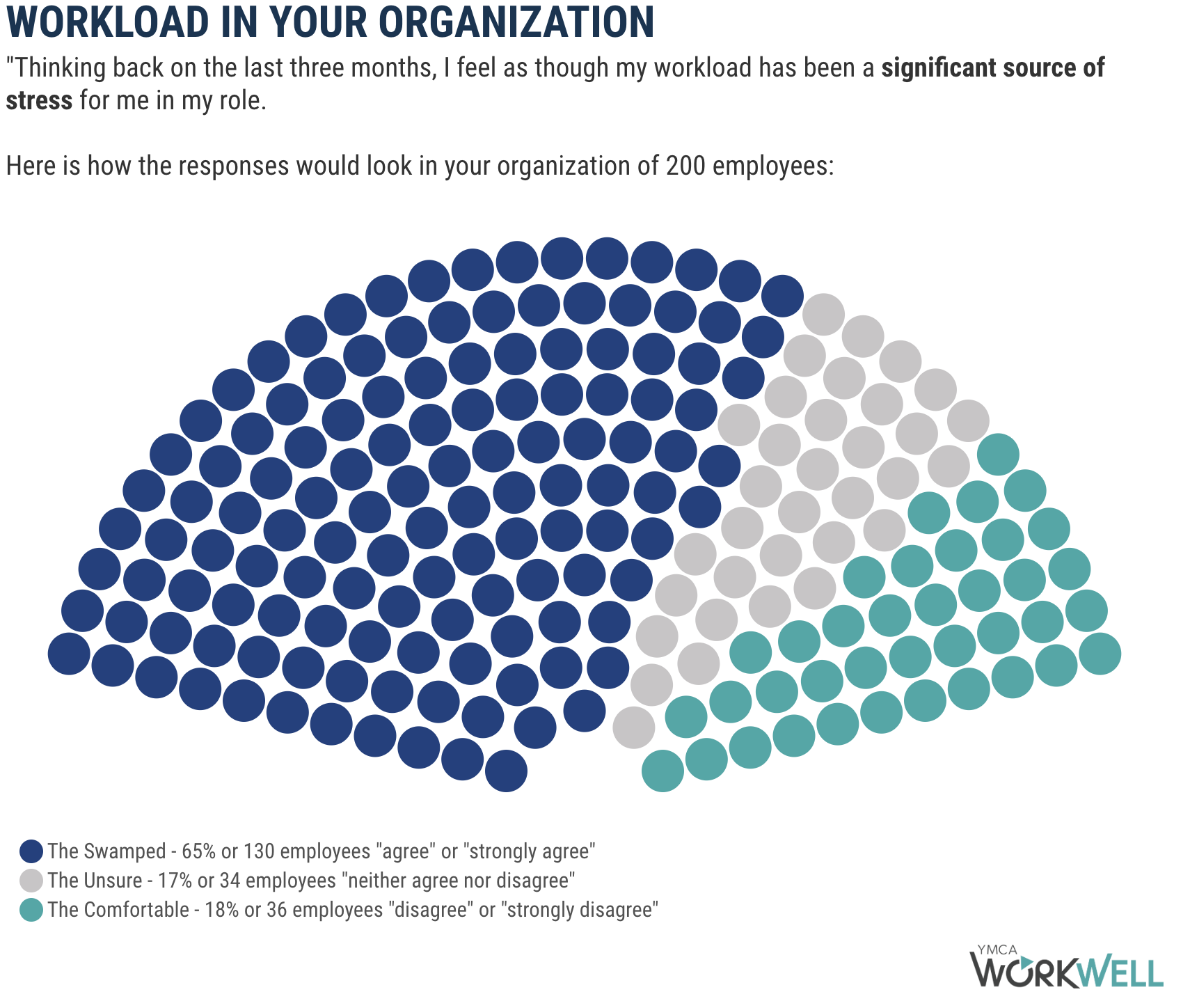At YMCA WorkWell, we're on a mission to identify, research and take action on the top organizational challenges to employee well-being - and right now, that is burnout. Our 2021 Workplace Well-Being Report found that 73% of respondents reported feeling burnt out sometimes to very often and by our 2022 Special Interest Report, that number had risen to 76%. In a recent blog, my colleague, Dr. Dave Whiteside, highlights why organizations should care so much about burnout. And if you’re an employee experiencing burnout yourself, please see my blog on strategies to help you. But in today’s blog we’re focusing in on the top cause of burnout: Workload.
Now... Irony alert: I tried to write this blog about workload last fall. I got most of it done… but my own workload kept getting in the way. Six months later, here we are.
If that doesn’t perfectly capture the challenge, I don’t know what does.
So let’s talk about it — honestly, practically, and with empathy.
"We Know It's a Problem... But We Can't Do Anything ABout It"
When I bring up workload with leaders, I often hear the same thing:
“We’re all drowning — but there’s nothing we can do about it.”
That reaction is understandable. But it’s also a story we’ve started to accept as truth — and it’s holding us back from meaningful change. I don’t believe we need to stay on the hamster wheel of doing more with less. All it takes is the courage to stop the spin.
Yes, addressing workload is hard. But that doesn’t make it impossible. We just need to start by telling the truth:
Heavy workloads are not inevitable. And we are not powerless.
Start By Asking: How Does Your Workload Feel?
Take a moment. Close your eyes. (Okay — finish reading first.)
Now take five deep breaths, and ask yourself:
“How does my workload make me feel?”
Notice your body. Your thoughts. Your tension.
What emotions come up? Overwhelm? Frustration? Exhaustion?
Now imagine every person on your team doing this same exercise. Multiply that emotional weight — and the scale of the problem becomes clear.

In our 2022 Special Interest Report, we found that 2 in 3 employees said workload was a major source of stress in the past 3 months.
That’s not just a wellness issue — it’s a productivity issue. A retention issue. A trust issue.
Burnout, by definition, is “a syndrome resulting from chronic workplace stress that has not been successfully managed.” If workload is driving stress — and burnout is costing your people — then we as leaders have a responsibility to act.
More Hours ≠ More Work
Let’s challenge a long-standing myth:
Being busy isn’t the same as being productive.
We’ve built a culture where overwork is a badge of honour. We still hear things like:
- “The best employees are first in and last out.”
- “Success means always being available.”
But research shows this mindset is toxic — and ineffective.
- Productivity per hour drops significantly after 50 hours a week.
- Workplaces that glorify “hustle” see higher rates of burnout, absenteeism, and even physical illness.
- Japan literally has a word for this: karoshi — “death by overwork.”
So, if all those extra hours don’t actually lead to productivity, why does the myth persist? And why are we working all these hours? Beyond the motivation/productivity myths, I believe it’s trying to keep up with our workload in our “always on” culture – but at the expense of our well-being and happiness.
This isn’t just about culture. It’s about lives. And it’s time for change.
So, Where Do We Start?
Shift The Mindset
We have more power than we think. Overworking isn’t noble — it’s harmful. Being perpetually busy isn’t a status symbol — it’s a warning sign.
As leaders, we must model the shift.
- Prioritize what actually matters.
- Involve your team in identifying focus areas.
- Protect your team’s best brain time for deep work — not meetings and fire drills.
If everything is a priority, nothing is.
Stand Up To The Excuses
Study after study confirms it: more hours ≠ more output.
High workloads lead to:
- Lower productivity on average
- Higher burnout
- Increased absenteeism
- Disengagement and absenteeism
If you want better results, the answer isn’t more — it’s better.
Lead with Data and Courage
Want to know how your team is really doing? Ask them.
Our Employee Insights Survey includes dedicated burnout and workload questions. We’ve helped hundreds of teams get a clear picture of what’s working, what’s not, and where to focus.
If you’re ready to move from assumption to action, start there.
Model the Way
You need to lead by example.
- Take your vacation.
- Respect boundaries.
- Stop sending emails at midnight.
- Encourage your team to log off when the day ends.
There’s always more work to do. But there’s only one you — and one them. Show your team that rest is part of how you lead. Breaking the cycle is hard, but that's why it's so important.
The Bottom Line
The problem of workload is real — but so is your ability to change it.
It starts with one step. One mindset shift. One leader saying:
“We don’t have to do it like this anymore.”
And yes — that leader can be you.
Need help tackling workload and burnout in your organization? Book your free consultation today to find out how our Employee Insights and Leader Coaching can help you build a healthier path forward. If you're ready to get off the hamster wheel, we'd love to help.